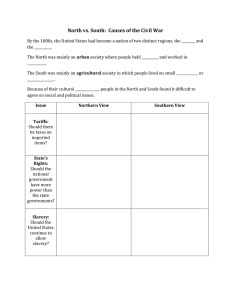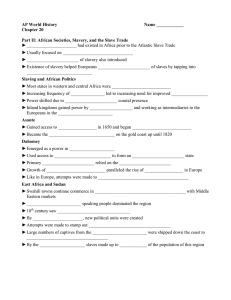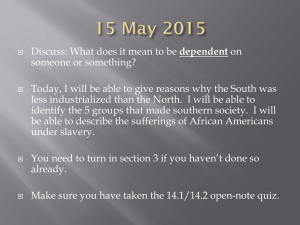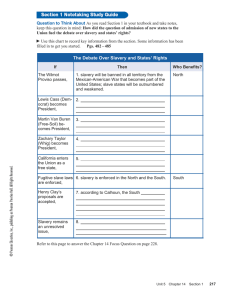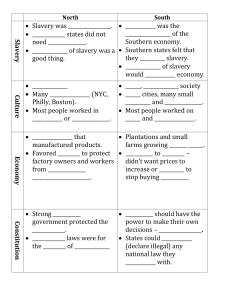slavery part 1 - Child Trafficking
advertisement
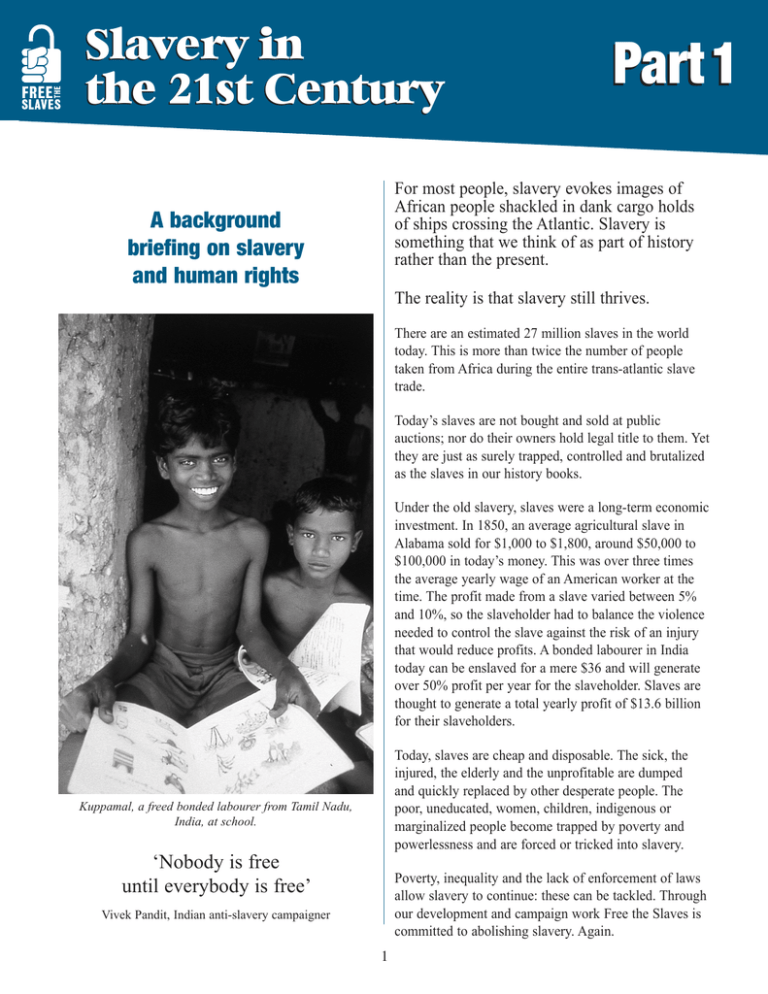
Slavery in the 21st Century Part1 For most people, slavery evokes images of African people shackled in dank cargo holds of ships crossing the Atlantic. Slavery is something that we think of as part of history rather than the present. Abackground briefingonslavery andhumanrights The reality is that slavery still thrives. There are an estimated 27 million slaves in the world today. This is more than twice the number of people taken from Africa during the entire trans-atlantic slave trade. Today’s slaves are not bought and sold at public auctions; nor do their owners hold legal title to them. Yet they are just as surely trapped, controlled and brutalized as the slaves in our history books. Under the old slavery, slaves were a long-term economic investment. In 1850, an average agricultural slave in Alabama sold for $1,000 to $1,800, around $50,000 to $100,000 in today’s money. This was over three times the average yearly wage of an American worker at the time. The profit made from a slave varied between 5% and 10%, so the slaveholder had to balance the violence needed to control the slave against the risk of an injury that would reduce profits. A bonded labourer in India today can be enslaved for a mere $36 and will generate over 50% profit per year for the slaveholder. Slaves are thought to generate a total yearly profit of $13.6 billion for their slaveholders. Today, slaves are cheap and disposable. The sick, the injured, the elderly and the unprofitable are dumped and quickly replaced by other desperate people. The poor, uneducated, women, children, indigenous or marginalized people become trapped by poverty and powerlessness and are forced or tricked into slavery. Kuppamal, a freed bonded labourer from Tamil Nadu, India, at school. ‘Nobody is free until everybody is free’ Poverty, inequality and the lack of enforcement of laws allow slavery to continue: these can be tackled. Through our development and campaign work Free the Slaves is committed to abolishing slavery. Again. Vivek Pandit, Indian anti-slavery campaigner 1 What is today’s Slavery? Trafficking People are enslaved by violence and held against their wills for the purposes of exploitation: this is the meaning of slavery today. This involves the transport and/or trade of humans, usually women or children, for economic gain and involving force or deception. Often migrant women and girls are tricked and forced into domestic work and prostitution. Women from Asia, Africa, Central and Eastern Europe and South America are trafficked frequently to regions such as the US, EU, Japan and the Middle East. In 1926, the League of Nations defined slavery as ‘the status or condition of a person over whom any or all of the powers of ownership are exercised’. While today’s slaves are not legally ‘owned’ by slaveholders, they are held in captivity, often in remote areas and usually through force or violence. Early and forced marriage Women and girls are married without choice and forced into a life of servitude, and often physical violence. This occurs in North Africa and some Asian countries. Today a slave is: to work – through mental or physical • Forced threat Traditional or ‘chattel’ slavery or controlled by an ‘employer’, usually • Owned through mental or physical abuse or threatened Today people are still bought and sold as commodities. They are often abducted from their homes, inherited or given as gifts. This is common in West Africa, particularly Mauritania. abuse constrained or has restrictions placed • Physically on their freedom of movement What types of slavery exist today? Why does slavery exist? People become slaves because they are poor, vulnerable and their basic rights are not protected. Lack of access to work, land, education and lack of enforcement of laws prohibiting the holding of people in bondage result in slavery. Slavery provides ‘employers’ with a form of extremely cheap labor which they will fight to hold onto. Bonded labor A person becomes bonded when their labor is demanded as a means of repayment of a loan or money given in advance. There are 20 million people working as bonded laborers worldwide. This is particularly common in India, Pakistan, Nepal, Brazil and the Caribbean. Forced labor A person who is poor and in need of money, perhaps for an emergency or because one of the family is ill, finds it hard to get a loan. The only option is to pledge their labor to repay their debt. Some resort to selling one of their children. This affects people who are illegally recruited by governments, political parties or private individuals, and forced to work, usually under threat of violence. Burma’s military dictatorship enslaves tens of thousands of people to work as porters for the army or on government construction projects every year. People who are enslaved are usually unaware that they have legal rights to freedom or are unable to take action to defend their rights, because of the threat of violence. They may be bound by a sense of misplaced duty or may be mentally accustomed only to slavery. Worst forms of child labor This refers to children who work in dangerous or exploitative conditions. While not all child labor is slavery, millions of children worldwide work in conditions of slavery. Slavery is illegal in virtually every country worldwide, but governments are rarely willing to enforce the law or to punish those who profit from slavery. Commercial sexual exploitation of children Free the Slaves supports local organisations which are working to liberate people from slavery. Free the Slaves also campaigns at the international level to have slavery abolished. Children are exploited through prostitution, trafficking and pornography. They are often kidnapped, bought, or forced to enter the sex market. Child sex tourism is particularly common in Asia. 2 child labor, servile domestic works, forced labor and servitude for ritual or domestic purposes. Governments are under obligation to take urgent action to prevent these. 1966 International Covenant on Civil and • The Political Rights echoes the rights outlined in the above treaties. The power within the UN to enforce these treaties is weak however. States are not required to report on measures taken against slavery nor is there any permanent monitoring committee or rapporteur on slavery. The United Nations Working Group on Contemporary Forms of Slavery, formed in 1974, reports to the UN Commission on Human Rights. States can choose, but are not obliged, to present information to the annual meeting of this working group. Non-Governmental Organizations can also present their reports to this group. International Labor Standards The International Labour Organization (ILO) is a part of the United Nations and has 175 member states. The ILO is responsible for developing international human rights conventions that relate to the world of work and for ensuring that they are respected. Human Rights and Slavery The ILO is a tri-partite organization where decisions are made by representatives of trade unions, employers’ organisations and governments. Slavery, in all its forms, has been outlawed in international human rights treaties, in international labor rights agreements and in almost every country worldwide. Nonetheless it persists as a grave abuse of human rights in many countries. Conventions that relate particularly closely to slavery include the Forced Labor Convention, 1930 (No. 29), which is one of the most widely ratified conventions and the Worst Forms of Child Labor Convention, 1999 (No. 182), which provides additional tools for the elimination of all forms of child slavery. Four major international human rights treaties prohibit slavery: 1926 Slavery Convention of the League of • The Nations, the predecessor to the United Nations. Under the ILO’s constitution, member states must report annually to the ILO on measures taken to implement all Conventions they have ratified. Non-Governmental Organizations can also submit information to the ILO Committee of Experts which produces annual reports on States’ compliance with conventions. 1948 Universal Declaration of Human • The Rights states that: ‘No one shall be held in slavery or servitude; slavery and the slave trade shall be prohibited in all their forms.’ (Article 4) 1956 Supplementary Convention on the • The Abolition of Slavery, the Slave Trade and The Committee of Experts makes recommendations and decrees actions which each government must take to end slavery and other human rights abuses related to work. Institutions and Practices similar to Slavery, banned ‘institutions and practices similar to slavery’: debt bondage, serfdom, servile marriage, 3 Bonded Labor Bonded labor is the most common modern form of slavery. It affects 20 million people worldwide. A person becomes bonded when their labor is demanded as a means of repayment of a loan or money given in advance. Free the Slaves supports organizations in India that are working to help liberate bonded laborers, to rehabilitate ex-bonded laborers and to lobby their government for enforcement of laws abolishing slavery. For case studies and campaign actions on bonded labor see Part 4. There are at least 10 million bonded laborers in India. The vast majority of bonded laborers come from the dalit (untouchable) and adivasi (indigenous) communities. Palanichami (30) and his wife Vasantha (25) live as bonded laborers on an estate in Tamil Nadu, Southern India. They start work in the fields before sunrise and are not allowed to rest and cook meals during the day. Their four children, aged from 7 to 12, all work also. Vasantha fell ill six years ago, so Palanichami borrowed 3000 rupees ($77) from the estate owner for medical treatment. Vasantha got better, but they were never able to repay the loan which with extortionate interest had amounted to 15,000 rupees ($387). They fear the debt will never be repaid. Secretly, they are members of an organization called READ. READ helps families such as Palanichami and Vasantha’s to gain freedom through a legal process. They hope to follow in the steps of neighbors who were recently liberated, but they still live in fear of the violence meted out by the landlord for attending meetings with READ. Freed bonded labourers Palanichami, Vasantha and children. FACTSHEET:Slaveryinthe21stCentury There are an estimated 27 million slaves alive today. The majority, up to 20 million, are bonded laborers in India, Pakistan, Bangladesh and Nepal. In one area of the South of Sudan, 3,000 children from a Christian population of 150,000 were abducted during 1998 to work as laborers. Today’s slave population is over five times greater than the population of the island of Ireland. About 14% of Haiti’s under-18 population, or 300,000 children, are restaveks – children working as domestic slaves. Thirty percent receive only one meal per day. Slavery was legally abolished in the British Empire in 1838, in Brazil in 1888, in Burma in 1929, in Saudi Arabia in 1962 and in Mauritania in 1980. Slavery still exists in all these areas. An estimated 40,000 women and young girls from Burma are forced in the sex industry in Thailand each year. The CIA and US State Department estimate that over 50,000 women and children are trafficked into the US each year. In Mississippi in 1850 an agricultural slave cost the equivalent of $50,000 to $100,000 at today’s prices. An equivalent slave in India in 1999 cost just $90. Between 1988 and 1998 there were over 100,000 slaves on 226 estates in Brazil, according to the Pastoral Land Commission (CPT). In India or Nepal, a person can be trapped into a lifetime of hard labour just to pay the interest on as little as $36. 4
